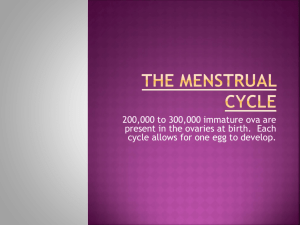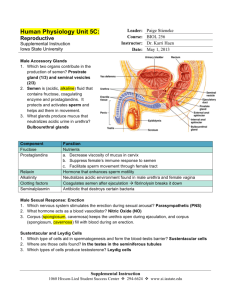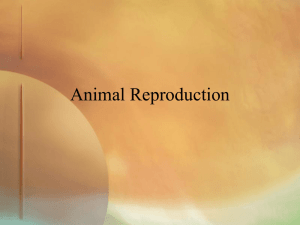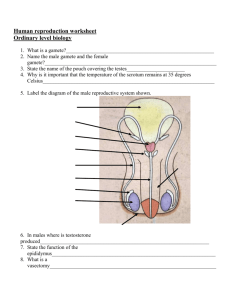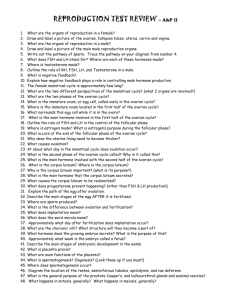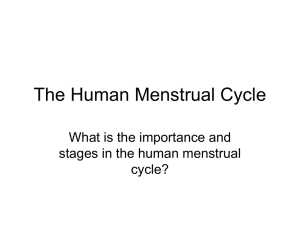Animal Reproduction - Bioenviroclasswiki
advertisement
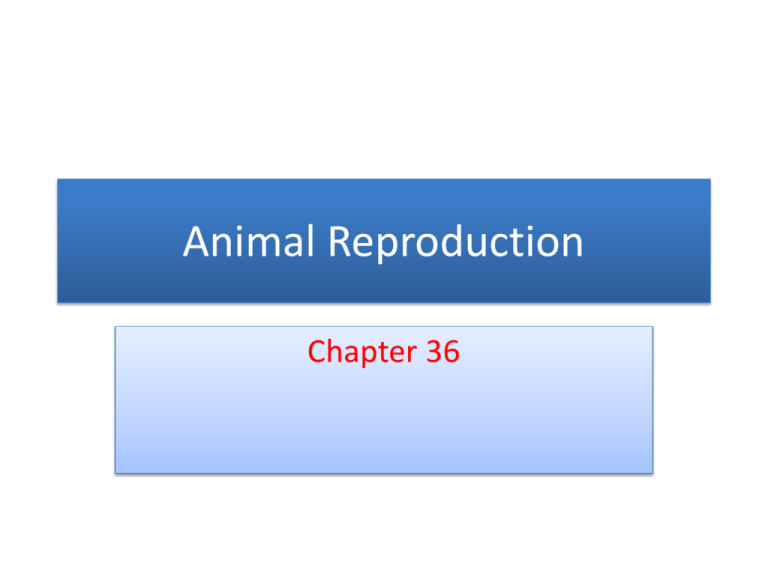
Animal Reproduction Chapter 36 Asexual Reproduction • Asexual reproduction involves only a single animal. The animal produces offspring through repeated mitosis of cells in some part of its body. • The offspring are, genetically identical to the parent. Sexual Reproduction • It requires the production of haploid gametes through meiosis. • During fertilization, two gametes usually from separate parents fuse and give rise to a diploid individual. • Since the offspring receives genes from each of its two parents, its genome is not identical to that of either parent. Types of Asexual Reproduction • Budding • Sponges and cnidarians, such as Hydra, and sea anemones, reproduce by budding. A bud grows directly from the body of the adult, drawing nourishment from its parent. When it has grown old enough, it breaks off and becomes an independent individual. Gemmules • In this form of asexual reproduction, a parent releases a specialized mass of cells that can develop into offspring. Sponges exhibit this type of reproduction. Fragmentation • In this type of reproduction, the body of the parent breaks into distinct pieces, each of which can produce an offspring. Planarians exhibit this type of reproduction. Regeneration • In regeneration, if a piece of a parent is detached, it can grow and develop into a completely new individual. Echinoderms exhibit this type of reproduction • Hydra, planaria, and earthworms also exhibit regeneration. Binary Fission Parthenogenesis • This type of reproduction involves the development of an egg that has not been fertilized into an individual. • Male honeybees develop from unfertilized eggs and are haploid; their diploid sisters develop from fertilized eggs. • Some fish, amphibians, and reptiles reproduce parthenogenetically, but restore the diploid number of chromosomes either before or after meiosis. All the resulting offspring are females. Advantages and disadvantages of asexual reproduction • Advantages • Animals that remain in one particular place and are unable to look for mates would need to reproduce asexually. • Numerous offspring can be produced without "costing" the parent a great amount of energy or time. • A disadvantage of this type of reproduction is the lack of genetic variation. All of the organisms are genetically identical and therefore share the same weaknesses. If the stable environment changes, the consequences could be deadly to all of the individuals. Male Reproductive System Female Reproductive System Label the Parts Structure of female reproductive system: • Ovaries are a pair of compact bodies located in the abdominal cavity attached to the dorsal body wall by a fold of peritoneum. • It has been estimated that after birth, each ovary contains about 300,000 ova. But only a few reach maturity. • The ovaries of the sexually matured female contain ova at various stages of development. The final stage is a structure called corpus luteum. • Fallopian tube: Close to each ovary is a funnel shaped structure called Fallopian tunnel. It receives the ova as they are sent out of the ovary. The Fallopian funnel leads to a narrow tube called Fallopian tube. • The two Fallopian tubes open behind the uterus. Contd.. • Uterus: It is a hollow, thick walled muscular organ situated in the pelvic cavity between the bladder and the rectum. The inner lining is the mucus membrane the endometrium. • The main function of the uterus is to prepare the endometrium to receive the fertilized ovum. • Vagina: This is a muscular tube lined with mucus membrane connecting the cervix at the upper end and with external genitalia at the lower end. Vagina serves as a birth canal. Spermatogenesis Spermatogenesis • Germ cells near the outer wall of the seminiferous tubules of the testis differentiate into stem cells called spermatogonia. • Spermatogonia divide by mitosis, and mature into primary spermatocytes. • Each primary spermatocyte undergoes meiosis: • meiosis I yields 2 haploid secondary spermatocytes • meiosis II yields 4 equal-sized spermatids. • The spermatids migrate toward the lumen (central opening). Sertoli cells supply nutrients for the spermatids, which mature into motile sperm in the Spermatogenesis Structure of the human sperm The human sperm has a head with a haploid nucleus. Atop the nucleus lies a specialized lysosome called the acrosome. It contains enzymes that will dissolve protective layers around the egg and enable the sperm to enter and fertilize it. Behind the head is the midpiece, which is packed with mitochondria. These organelles provide the energy needed to move the tail. Whiplike miovement of the tail, which is really a long flagellum, propel the sperm through the female reproductive tract. Oogenesis Oogenesis, is the formation of egg cells, begins in the developing ovaries of a female fetus. Precursor cell is called oogonia and they divide my mitosis to form primary oocyte (by the end of third month of fetal development, no oogonia remain, as they have all divided by mitosis and grown into primary oocytes) The ovaries start out with 2 million primary oocytes. At puberty only about 400,000 primary oocyte remain. Surrounding each oocyte is layer of smaller cells that nourish the developing oocyte and secrete female sex hormones. Oocyte together with these accessory cells make up the follicle. During the menstrual cycle, primary oocyte completes its first meiotic division to form a single secondary oocyte and a polar body. Oogenesis • The accessory cells of the follicle secrete estrogen. As the follicle matures, it grows, eventually erupting through the surface of the ovary and releasing the secondary oocyte, a process called ovulation. • The secondary oocyte travels through the uterine tube or Fallopian tube. If the egg/secondary oocyte is fertilized it may undergo the second meiotic division while in the uterine tube. • Some of the follicle cells accompany the egg, but most remain in the ovary and they enlarge and become glandular, forming the corpus luteum. The corpus luteum secretes both estrogen and progesterone. If fertilization does not take place, corpus luteum breaks down a few days later Ovulation Menstrual cycle • Starting at the age of puberty, human females begin a hormonal cycle known as the menstrual cycle. • Each cycle lasts on an average, 28 days. • The purpose of this cycle is to time the release of an egg or an ovum (ovulation) for possible fertilization and later implantation into the inner lining of the uterus. This implantation must occur when the uterine lining (the endometrium ) is rich with blood vessels. • The highly vascular endometrium is not maintained if there is no implantation. • The breakdown of the blood vessels leads to the menstrual bleeding. Hormones controlling menstrual cycle • Hypothalamus is the regulatory centre of the menstrual cycle. • The hypothalamus produces a hormone known as gonadotropin releasing hormone (GnRH). • The target tissue of this hormone is the near by pituitary gland and it results in the pituitary gland producing two hormones into the blood streamfollicle stimulating hormone and luteinizing hormone. The target tissues for these two hormones are the ovaries. • • • • • • The outer ring of follicle cells remains within the ovary. The cells of this outer ring begins to divide and fill in the area left by ovulation and this forms a glandular structure known as corpus luteum. Corpus luteum is hormonally active and produces a hormone-progesterone. Progesterone is a hormone that maintains the thickened, highly vascular endometrium and the embryo will be able to implant. Estrogen levels rise to a peak and stimulate LH secretion by the pituitary gland. High levels of estrogen and progesterone are a negative feedback signal to the hypothalamus. The hypothalamus does not produce GnRH when these hormone levels are high. So FSH and LH remain at a level not conducive to the production of another Graffian Follicle during this time. IF there is no pregnancy, the corpus luteum begins to break down and then there is a decline in both progesterone and estrogen levels. As both of these levels fall, the highly vascular endometrium can no longer be maintained. The capillaries and small blood vessels begin to rupture and menstruation begins. The drop in progesterone and estrogen levels also signals the hypothalamus to begin secreting GnRH and thus normal menstrual cycle begins. • Effects of hormones (FSH , LH, Progesterone, estrogen)on the ovaries: • One of the effects of FSH and LH on the ovaries is to increase the production and secretion of another reproductive hormone by the follicle cells of ovaries. • The hormone is estrogen. Estrogen enters the blood stream. It’s target tissue is the endometrium of the uterus. The result is the highly vascularized endometrium. • Another effect of FSH and LH is the production of structures within the ovaries called the Graffian follicles. • • A spike in the level of FSH and LH leads to ovulation. (release of oocyte from the Graffian follicle) This enters the fallopian tube soon after ovulation. Review • Sexual maturity in women is marked by the beginning of the menstrual cycles. These cycles coordinate the development and release of an egg with the conditions required in the uterus to support a pregnancy. • The cycle is controlled by hormones from both the brain (FSH and LH) and the ovary(oestrogen and progesterone). • The natural cycle repeats until there is either a pregnancy or the woman reaches menopause and the end of the reproductive phase of her life. • FSH and LH are two hormone that are active at significant phases of human development including primary and secondary sexual characteristics. They are both significant hormones in the primary sex determination. Following puberty human become fertile and in females this is manifest as the menstrual cycle. Anterior Pituitary Hormones • Follicle Stimulating hormone (FSH) • Stimulates the development of a primary follicles (oocytes). • Increases the number of follicular cells which in turn produce oestrogens. • Produces follicular fluids. • Develops the oocyte in the follicle. • Luteinising Hormone (LH): • surges in mid cycle (12 days) to bring about ovulation. • high LH is associated with a resumption of meiosis in the oocyte. Meiosis has been arrested in Prophase I since the embryonic stage. Only at the point of fertilisation does meiosis complete. • stimulates the development of the corpus luteum. Ovarian Hormones • Oestrogen: • Stimulates the development of the endometrium (lining of the uterus) and it associated blood supply. • During the first half of the cycle there is positive feedback through increased sensitivity of the follicle cells to FSH (Up-regulation of receptors on the follicular cell plasma membrane). • During the second half of the cycle (high oestrogen) there is negative feedback on FSH and LH. Progesterone: • maintains the lining of the endometrium • negative feedback on FSH and LH Menstrual cycle and hormonal interaction Menstrual cycle is generated by interactions among the hormones of the hypothalamus, the anterior pituitary, and the ovaries. Fertilization • Fertilization is internal. Sperms and eggs live only for a few days if fertilization does not occur. Fertilization can succeed only if copulation occurs within a couple of days before or after ovulation. The cells surrounding the egg called corona radiata, and an inner jelly like layer called zona pellucida for a barrier between the sperm and the egg. Fertilization • In the uterine tube, hundreds of sperm reach the egg and encircle the corona radiata, each sperm releasing enzymes from its acrosome. These enzymes weaken both the corona radiata and the zona pellucida, allowing the sperm to wriggle to the egg. • Why do you think may sperms approach one egg? • When the first sperm finally contacts the surface of the egg, the plasma membranes of egg and sperm fuse, and the sperm’s head is drawn into the egg’s cytoplasm • Two changes take place as the sperm enters • Vesicles near the surface of the egg release chemicals into the zona pellucida, reinforcing it and prevents polyspermy. • The egg undergoes second meiotic division forming the haploid gamete. • Fertilization occurs as the haploid nuclei of sperm and egg fuse forming a diploid nucleus that contains all the genes of a new human being. Family planning Vasectomy Tubectomy Family Planning Family planning • Read page number 736-737 and go over the Table 36-3
